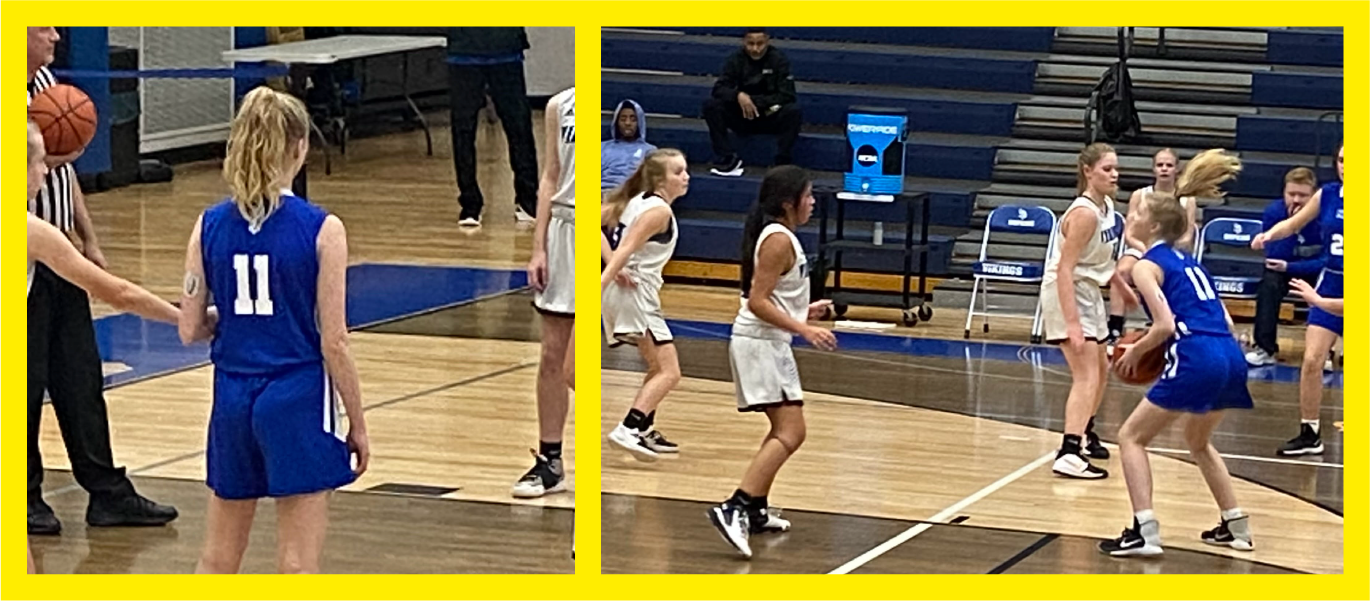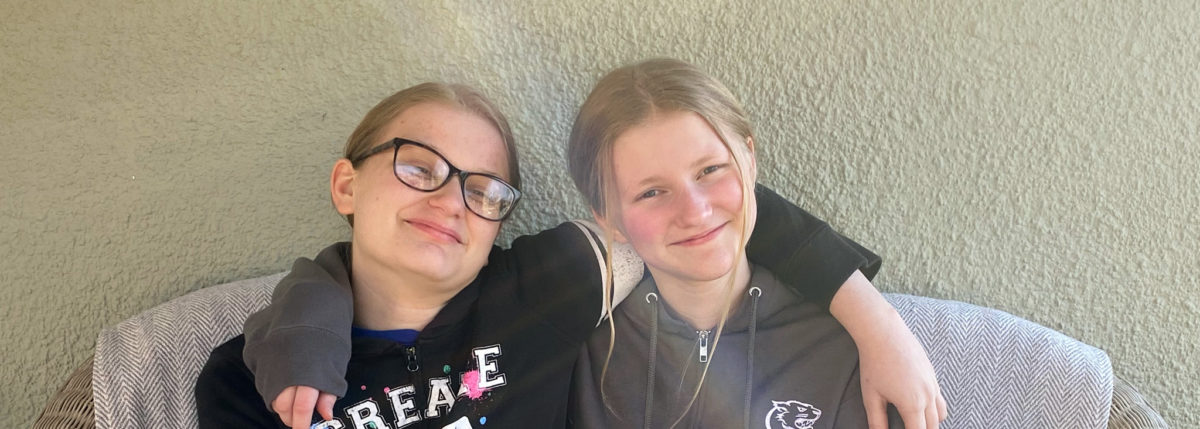Teen Sisters Manage T1D with Sarcasm, Tenacity, and Closed-Loop Insulin Pumps
Audrey Brand was diagnosed with type 1 diabetes at only 3 years old in 2009. It wasn’t until she was in the fifth grade that she was able to feel the symptoms of low blood sugars.
“She could walk around with a blood sugar around 1.6 mmol/L30 mg/dL and act completely normal, totally unaware that she was low,” explains her mother, Heather. The Brand family has four children—two of whom have type 1 diabetes.
“Our endocrinologist explained that when a child is diagnosed with type 1 diabetes (T1D) at such a young age, it can be harder for them to feel and notice the symptoms, even as they get older,” recalls Heather.
“We worried a lot, to say the least. Fortunately, she never passed out from a low when she was younger.”
Fortunately, by the time Audrey turned 4 in 2010, she started using one of the earlier models of the Dexcom continuous glucose monitor (CGM). While not nearly as reliable as today’s Dexcom technology, it did provide more peace of mind.
In 2011, Carissa—Audrey’s little sister—was diagnosed with T1D at 3 years old.
“It was easier to tell when Carissa was low, she had obvious symptoms, and she could feel her symptoms when she was only 6 years old,” explains Heather.
Today, at ages 16 and 14, Audrey and Carissa both use the TSlim Control IQ closed-loop system with a Dexcom CGM to manage their diabetes.
“Sometimes, watching the basketball games, I forget about Carissa’s type 1 and just enjoy the game,” says Tim Brand, Audrey and Carissa’s father. “That’s how good the system is. It is peace of mind.”
We’ll hear more from mom and dad in a moment. First, let’s talk to the young ladies living with T1D.

Audrey: “How do I feel about diabetes? ‘Bleh, it sucks.’”
16-year-old Audrey is an artist—with a preference for painting acrylic on canvas. Her family agrees with her self-description as a sarcastic joker and a very proud collector of Pop Its and fidget toys.
When asked, “How do you feel about living with diabetes?” Audrey’s answer conveys just how smoothly her sarcastic and cheeky personality gets her through the challenges of T1D.
“Bleh, it sucks,” she says. Despite her honesty, she truly does endure T1D with her own version of silly and tenacious grace.
“One time in the fourth grade,” recalls Audrey, “my CGM started beeping and a kid in my class was like, ‘Is that a phone?’ I just give people a dirty look when they say things.”
Like anyone with T1D of any age, Audrey knows there are areas of management she does well and areas she could improve on.
“I’m really good at learning how to change my infusion sites,” says Audrey. “But I’d like to get better at remembering to bolus when I eat.”
She’s also tired of the common public misconceptions.
“I wish more people understood that cinnamon doesn’t cure it and sugar doesn’t cause it.”
Carissa: “It gets in the way….’”
At 14 years old, Carissa is also an artist—preferring pencil and paper. She is an aspiring athlete making her mark on the basketball court and singing in her school’s choir and chorale.
“I don’t like diabetes because it gets in the way of sports and the extracurricular activities that I do,” says Carissa, who’s closed-loop pump definitely helps her on the court.

But has it actually held her back? Or has it simply made her path more challenging? Carissa may not see, until she’s older, just how hard she works on the court despite her diabetes, instead of feeling like it’s slowing her down.
“I was in a game once and an opponent accidentally ripped my CGM out of my arm,” recalls Carissa. “I’ve had insulin pump infusion sites pulled out, too, when the cord gets caught on somebody.”
Compared to her older sister, Carissa has been using a closed-loop system for most of her life with diabetes simply due to the year of her diagnosis. But that doesn’t mean it’s always easy to wear.
“I don’t mind the CGM alerts when I’m at home,” she says, “but it’s kind of annoying when I’m taking an exam at school. It’s probably annoying for everybody in class, but it happens enough that people just know it’s me. In a new class, it’s kind of scary when everyone looks at me.”

Carissa says she’s especially good at catching the symptoms when her blood sugar is rising or falling—before her CGM alerts her. But she’d like to get better at remembering to charge her pump overnight.
“I never remember to do it,” she says. “A charged pump only lasts two days. Then I get to school and realize the battery is about to die.”
A quick call to mom is Carissa’s backup plan for a dead pump battery at school.
“I do wish more people understood that sometimes I have to go eat something during basketball practice,” says Carissa. “I’ve gotten weird looks, like they think I just stopped to eat instead of practicing.”
“Diabetes technology has been a game-changer for our family.”
“Diabetes technology has been a game-changer for our family,” says Tim, “especially the G4, when it first came out. The accuracy was so much better than the earlier CGM. We also had a new baby, Henry. We got a lot more sleep thanks to the G4.”
When his daughters began looping with the T:Slim Control IQ and a Dexcom CGM, Tim says the mental workload of T1D for the whole family became so much lighter.
“Both of their A1cs improved, everyone is sleeping better. There’s just less mental work.”
Mom agrees.
“Looping has taken a lot of pressure off me,” says Heather. “Before looping, I was constantly watching the blood sugars on the Follow app, because the girls got so used to the beeps and alarms, they just ignored them a lot of the time. Before looping, I had to text them a lot and confirm that they took insulin to correct the highs or treat the lows.”
Looping means far less nudging, nagging and reminding from mom and dad.
Preventing low blood sugars overnight has been one of the biggest blessings.
“They don’t wake up on their own during their lows,” says Heather, who appreciates the closed-loop system’s ability to suspend insulin during falling blood sugar levels. “We joke that Carissa is a zombie, she will just walk in the middle of the night, get a juice box, drink it, and have no idea what she’s doing. She almost ate a test-strip one night when we handed it to her for a rare finger prick.”
To keep the kids from snacking on candy in their rooms, the family doesn’t keep low treatments next to their beds. Yummy choices like Skittles and Starbursts would get eaten up as snacks, so they’ve resorted to something neither teen gets too excited about: marshmallows.
“They still call me all the time on my way home after dropping them off at school,” says Heather. “Their pump is about to die ‘cause it didn’t get charged, they’re about to run out of insulin. We’re trying to set more reminders on our phones, but you know, you’re dealing with the teenage brain.”
Teenage-brain nonetheless, Audrey and Carissa are clearly kickin’ butt and taking names when it comes to thriving with type 1 diabetes. How can you tell? They both have a sneaky smile on their faces throughout the interview, and it hasn’t stopped them in the slightest from pursuing their passions.
Educational content related to closed-loop pump technology is made possible with support from Dexcom, an active partner of Beyond Type 1 at the time of publication. Editorial control rests solely on Beyond Type 1.





